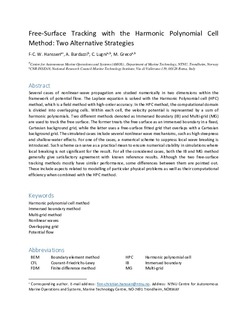Free-Surface Tracking in 2D with the Harmonic Polynomial Cell Method: Two Alternative Strategies
Journal article
Submitted version
Permanent lenke
http://hdl.handle.net/11250/2458219Utgivelsesdato
2017Metadata
Vis full innførselSamlinger
- Institutt for marin teknikk [3469]
- Publikasjoner fra CRIStin - NTNU [38525]
Originalversjon
10.1002/nme.5615Sammendrag
Several cases of nonlinear-wave propagation are studied numerically in two dimensions within the framework of potential flow. The Laplace equation is solved with the Harmonic Polynomial cell (HPC) method, which is a field method with high-order accuracy. In the HPC method, the computational domain is divided into overlapping cells. Within each cell, the velocity potential is represented by a sum of harmonic polynomials. Two different methods denoted as Immersed Boundary (IB) and Multi-grid (MG) are used to track the free surface. The former treats the free surface as an immersed boundary in a fixed, Cartesian background grid, while the latter uses a free-surface fitted grid that overlaps with a Cartesian background grid. The simulated cases include several nonlinear wave mechanisms, such as high steepness and shallow-water effects. For one of the cases, a numerical scheme to suppress local wave breaking is introduced. Such scheme can serve as a practical mean to ensure numerical stability in simulations where local breaking is not significant for the result. For all the considered cases, both the IB and MG method generally give satisfactory agreement with known reference results. Although the two free-surface tracking methods mostly have similar performance, some differences between them are pointed out. These include aspects related to modelling of particular physical problems as well as their computational efficiency when combined with the HPC method.
